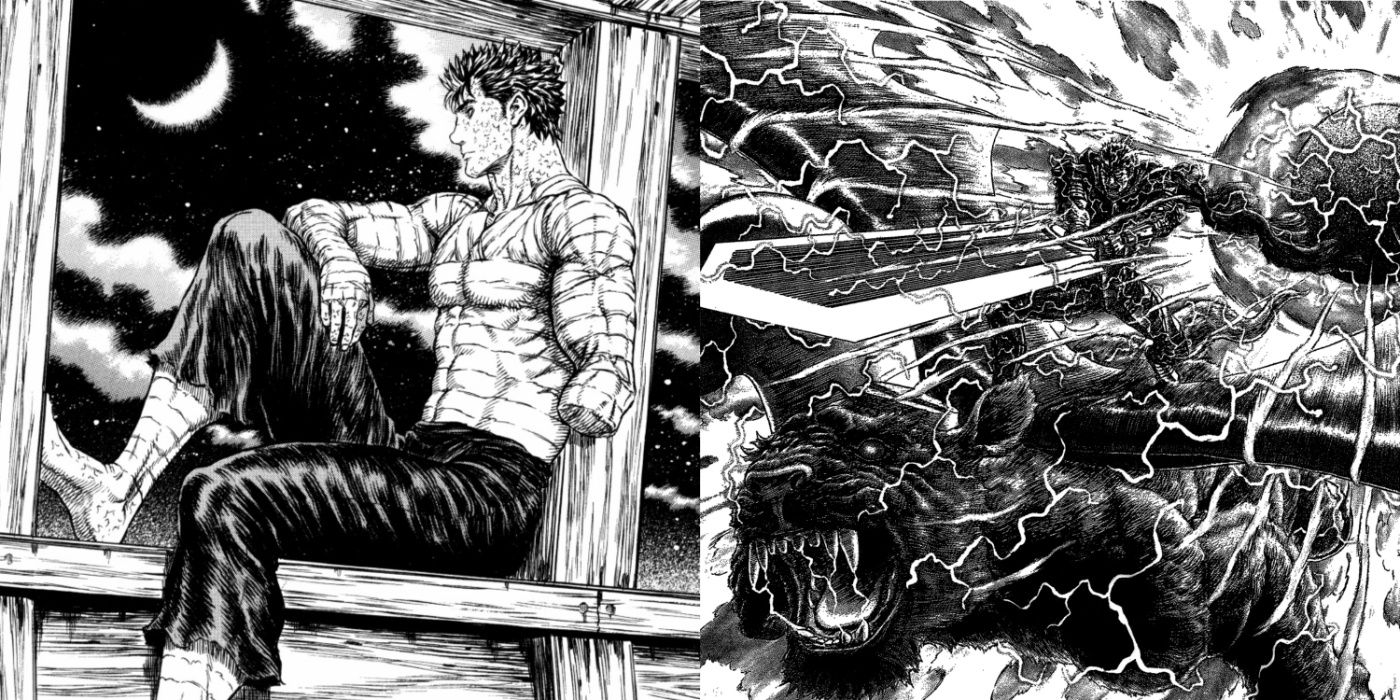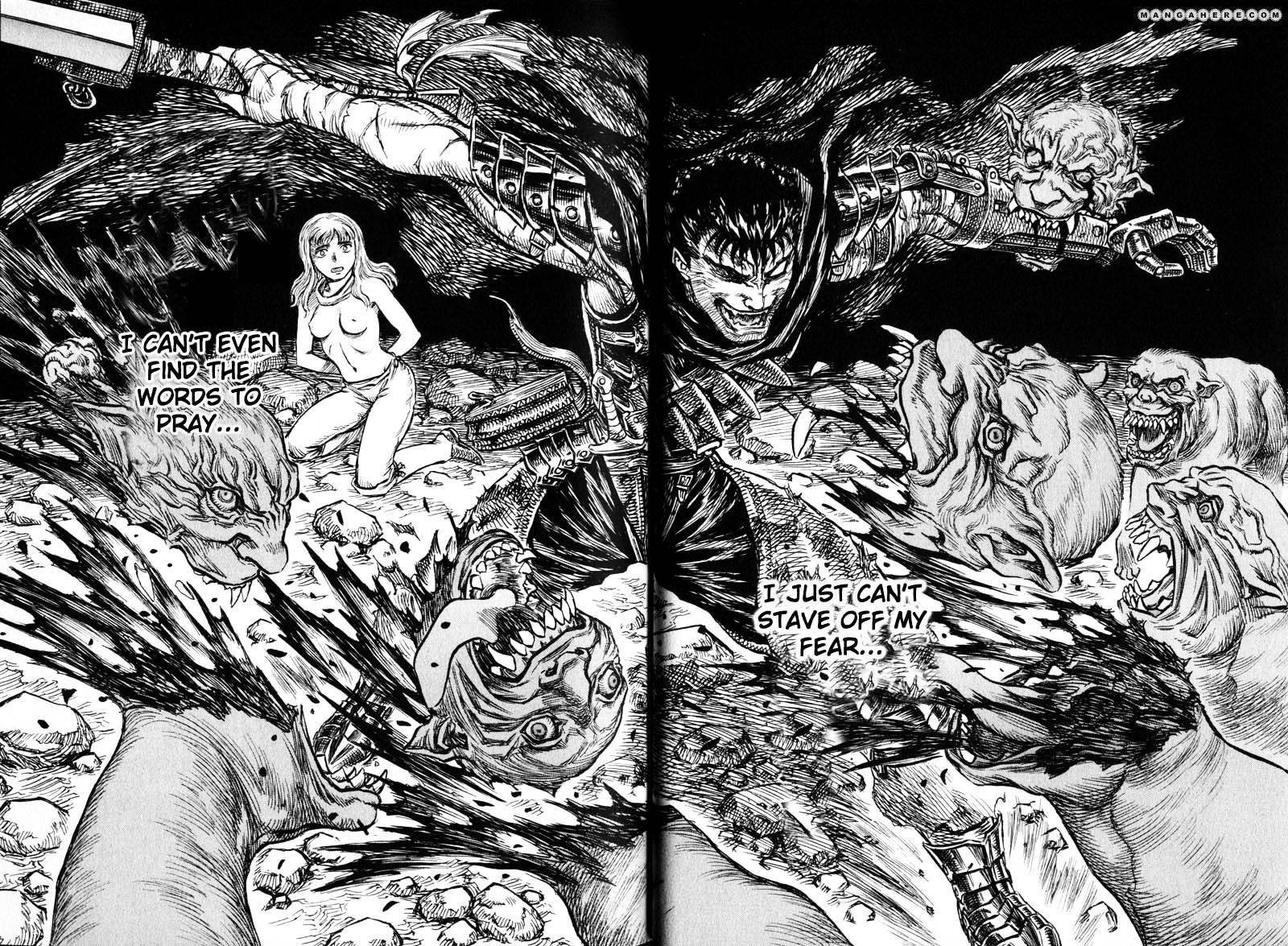Berserk manga panels: Yo, they’re way more than just drawings, dude. They’re a total trip through epic battles, dark fantasy, and seriously intense character development. Miura’s art style is iconic, evolving throughout the manga’s run, from the explosive energy of the Golden Age to the grittier, more mature style of the later arcs. We’re diving deep into the symbolism, panel composition, and the sheer impact these panels have on the story, man.
Get ready for a deep dive into the visual storytelling genius that is Berserk!
We’ll break down how Miura uses everything from panel size and perspective to light and shadow to create this totally unique and captivating reading experience. We’re talking about the evolution of Guts’ design, the recurring symbols like the Behelit, and how Miura’s style draws from other art forms to create something truly special. Prepare to have your mind blown by the sheer artistry and storytelling power packed into each and every panel.
Berserk’s Artistic Evolution: A Total Eclipse of Style
Yo, manga heads! Let’s dive deep into the insane artistry of Berserk, dissecting how Miura’s style evolved, the symbolism that slays, and the panel magic that keeps us hooked. From the Golden Age’s clean lines to the Conviction arc’s gritty detail, we’re breaking down what makes Berserk’s visual storytelling so freakin’ legendary.
Guts’ Design Evolution
Guts’ look? Total transformation, dude. Early Guts was leaner, more agile, reflecting his early mercenary days. His armor evolved from simple leather to that iconic, ridiculously massive, almost impractical behemoth of metal, mirroring his physical and emotional burdens. The scars?
Those are badges of honor, each one a brutal testament to his battles. His eyes? They tell a story all their own, shifting from youthful fire to weary determination.
Panel Styles: Golden Age vs. Conviction Arc
The Golden Age? Think cleaner lines, a more classic manga style, lots of dynamic action sequences. Conviction? It’s darker, grittier, way more detailed. The linework thickens, shadows deepen, reflecting Guts’ internal struggles and the increasingly brutal world around him.
The shift in style mirrors the shift in tone, taking us from epic adventure to dark, brooding fantasy.
Perspective and Composition: Creating Dramatic Tension
Miura was a master of perspective. He used extreme close-ups to amplify emotion, wide shots to showcase the scale of battles, and low angles to make Guts seem powerful and imposing. The way he composed panels, using leading lines and strategic character placement, built suspense and kept readers on the edge of their seats. Think of those panels showcasing the Eclipse – the sheer scale and horror are breathtaking.
Inking Styles Across Volumes
| Volume Range | Inking Style | Characteristics | Examples |
|---|---|---|---|
| 1-10 | Clean, detailed | Sharp lines, precise hatching | Early Guts design, Golden Age battles |
| 11-20 | Increased texture | More cross-hatching, rougher lines | Post-Eclipse Guts, Falconia arc |
| 21-30+ | Grittier, heavier | Thicker lines, emphasis on shadow | Black Swordsman arc, Island arc |
Symbolism and Motifs in Berserk
Beyond the epic battles and character drama, Berserk is packed with powerful symbolism. Miura uses recurring motifs to build layers of meaning, adding depth and enriching the overall narrative. These aren’t just pretty pictures; they’re keys to understanding the story’s deeper themes.
Recurring Visual Motifs and Their Significance
- The Behelit: The symbol of sacrifice and the pursuit of power, often associated with twisted desires and catastrophic consequences.
- Guts’ Swords: Representing his relentless struggle for survival and revenge, evolving in size and design to reflect his journey.
- Griffith’s Crimson Armor: A symbol of ambition, power, and the seductive allure of the dream, but also of his corruption and inhumanity.
- The Brand of Sacrifice: A constant reminder of Guts’ trauma and his fight against fate.
Light and Shadow: Mood and Emotion
Miura’s masterful use of light and shadow isn’t just about visual appeal; it’s about conveying emotion. Dark, shadowy panels often highlight moments of despair and fear, while brighter scenes can represent hope or moments of intense action. The contrast between light and darkness is a key element in establishing the mood and atmosphere of each scene.
Symbolic Panel Compositions

Panel composition plays a huge role in the storytelling. Character placement, framing, and the use of negative space all contribute to the symbolic meaning of individual panels. For instance, the isolation of a character within a panel can highlight their loneliness or vulnerability, while a character dominating the frame suggests power and dominance.
List of Recurring Symbols and Interpretations
- Eclipse: Destruction, chaos, the corrupting influence of power.
- Skulls: Death, loss, the pervasiveness of violence.
- Birds: Freedom, hope, or omens depending on the context.
- Dragons: Powerful forces of nature, chaos, or even divine intervention.
Panel Composition and Narrative Techniques
Miura’s genius isn’t just in his art, but in how he uses panels to tell the story. He masterfully manipulates panel size, arrangement, and transitions to control the pace, create dramatic impact, and guide the reader’s eye through the narrative. It’s like a visual symphony, perfectly orchestrated.
Panel Size and Narrative Pacing
Large panels, or splash pages, create impactful moments, slowing the pace and emphasizing the importance of the scene. Smaller panels, in contrast, accelerate the pace, perfect for depicting rapid action sequences or conveying a sense of urgency. The strategic use of both keeps the reader engaged and invested.
Splash Pages vs. Smaller Panels
Splash pages are like cinematic moments, grand and sweeping, often used to highlight a climactic battle or a powerful emotional revelation. Smaller panels, on the other hand, can be used to build tension, show subtle details, or create a sense of claustrophobia.
Gutters and Transitions
Gutters – the spaces between panels – aren’t just empty space. They’re integral to the narrative flow, guiding the reader’s eye and creating a sense of time and movement. Miura’s masterful use of gutters helps to create a seamless reading experience, transitioning smoothly between moments of action and reflection.
Character Portrayal Through Manga Panels: Berserk Manga Panel
Miura’s characters aren’t just drawn; they’re
-lived*. His masterful use of expressions, body language, and panel composition breathes life into Guts, Griffith, and the rest of the unforgettable cast. Each character has a unique visual identity, and their emotional journeys are vividly portrayed through the panels.
Portrayal of Guts and Griffith’s Emotions, Berserk manga panel
Guts’ expressions range from ferocious rage to quiet contemplation, reflecting his constant internal conflict. Griffith, on the other hand, often exudes an air of cold calculation and unwavering ambition, even in his moments of vulnerability. The contrast in their portrayals further enhances their complex relationship.
Visual Representation of Different Characters
Each character in Berserk has a distinct visual style that reflects their personality and role in the story. From the imposing figure of Guts to the elegant yet ruthless Griffith, Miura’s character designs are instantly recognizable and deeply memorable.
Panel Composition and Power Dynamics
The way characters are positioned within a panel often reveals the power dynamics at play. A character dominating the frame suggests superiority, while a smaller, less prominent figure may indicate vulnerability or subservience. Miura’s masterful use of composition effectively conveys these relationships.
Panels Showcasing Character Development
Throughout the manga, panels illustrate the evolution of the characters. Guts’ transformation from a ruthless mercenary to a weary warrior seeking redemption is visually portrayed through changes in his appearance, posture, and expressions. Similarly, Griffith’s descent into darkness is marked by subtle shifts in his demeanor and the way he is presented in panels.
Impact of Specific Panels on the Narrative

Certain panels in Berserk are iconic, not just for their artistic merit, but for their profound impact on the narrative. These panels often serve as pivotal moments, foreshadowing future events, or enhancing our understanding of key plot points. Let’s examine a few of these memorable moments.
Analysis of a Particularly Impactful Panel
The panel depicting Griffith’s transformation into Femto during the Eclipse is a prime example. The sheer horror and brutality of the image, coupled with the stark contrast between light and shadow, leaves a lasting impression on the reader. The panel’s composition, with Griffith’s distorted form dominating the frame, perfectly captures the catastrophic nature of the event.
Visual Elements Enhancing Plot Understanding
Many panels enhance our understanding of the narrative. For example, panels showing the subtle changes in Guts’ armor or weaponry often foreshadow upcoming challenges or changes in his fighting style. These visual details add depth to the story and enrich the reader’s experience.
Panels Foreshadowing Later Events
Certain panels subtly foreshadow events that occur later in the story. These foreshadowing elements can be subtle visual cues or symbolic imagery that only become clear upon revisiting the panel after the later events have transpired. This adds a layer of complexity and intrigue to the narrative.
Memorable Panel Sequences
Many memorable sequences are built upon a series of panels working together to create a powerful emotional impact. For example, the panels depicting Guts’ struggle during his battle with Zodd are a testament to Miura’s storytelling abilities, effectively capturing the brutality and intensity of the fight while also showing Guts’ emotional resilience.
Find out about how berserk manga read can deliver the best answers for your issues.
Influence of Other Art Forms on Berserk Panels
Miura’s style isn’t born in a vacuum. He draws inspiration from various art forms, blending them seamlessly into his unique manga style. This eclectic approach gives Berserk its distinctive visual richness and depth.
Influences from Painting, Sculpture, and Film
Miura’s work shows influences from various art forms. The dramatic use of light and shadow is reminiscent of Baroque painting, while the detailed rendering of anatomy and armor reflects a deep understanding of sculpture. The dynamic composition of panels and the use of cinematic techniques further enhance the narrative’s visual impact, showing influences from film.
Comparison with Other Artistic Mediums
Comparing specific panels to works from other artistic mediums reveals stylistic similarities. The intense emotional weight of certain panels is reminiscent of the dramatic power of Romantic painting, while the detailed depiction of anatomy and movement mirrors the precision of classical sculpture. The use of dynamic camera angles and dramatic lighting in Berserk’s panels also echoes the techniques of cinematic storytelling.
Adaptation of Traditional Artistic Techniques
Miura masterfully adapts traditional artistic techniques to the medium of manga. He uses perspective, composition, and light and shadow in ways that are both traditional and innovative, creating a unique visual language that is both compelling and expressive.
Table Illustrating Potential Influences
| Art Form | Specific Influence | Visual Manifestation in Berserk | Examples |
|---|---|---|---|
| Baroque Painting | Dramatic use of light and shadow | Chiaroscuro effects in many panels | Panels depicting the Eclipse |
| Classical Sculpture | Detailed anatomical rendering | Precise depiction of muscles and armor | Close-ups of Guts’ physique |
| Film | Dynamic camera angles and composition | Varied panel sizes and arrangements | Action sequences and dramatic reveals |
So, yeah, Berserk’s manga panels aren’t just pretty pictures; they’re the backbone of this legendary dark fantasy epic. From the raw emotion conveyed in character expressions to the masterful use of composition to build suspense and drive the narrative forward, Miura’s work is a masterclass in visual storytelling. Whether you’re a longtime fan or just getting into the series, appreciating the artistry of these panels adds another layer to the already intense and unforgettable Berserk experience.
It’s seriously next level stuff.



